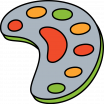One of the most challenging aspects of realistic drawing is achieving accurate proportions. Proportions determine how elements within your artwork relate to each other in terms of size, shape, and placement. Proper proportions ensure that your subject looks balanced and natural. Whether you’re drawing a human figure, an animal, or an inanimate object, understanding proportions is crucial for creating realistic drawings. In this article, we’ll explore how to master proportions and improve your realistic drawing skills.
1. The Importance of Proportions in Realistic Drawing
Proportions are fundamental to achieving realism in your artwork. Incorrect proportions can lead to distorted or unrecognizable drawings. For example, if the head is too large or too small compared to the body, it will break the natural flow of the figure. Understanding how to measure and compare different elements of your subject will help maintain balance and ensure everything fits together correctly.
When learning proportions, start by studying the general guidelines for the subject you’re drawing. While no two people or objects are the same, there are universal rules and ratios that can help guide your work. Once you’re familiar with these rules, you can adjust them for the specific subject you’re working on.
2. Using the Human Body as a Proportional Guide
One of the most common subjects in realistic drawing is the human figure. The human body follows specific proportional rules that artists can use to create more accurate and lifelike drawings.
Basic Proportions for the Human Body:
- The average adult human body is roughly 7 to 8 heads tall. This means that the height of the figure is approximately 7 to 8 times the length of the head.
- The width of the shoulders is about two heads wide, while the waist is about one and a half heads wide.
- The elbows usually align with the waist, and the wrists align with the hips.
- The legs are typically half the length of the body.
Understanding these general guidelines allows you to place the different parts of the body in the right relationship to each other. However, keep in mind that each person’s proportions may vary, so always observe your subject carefully and adjust accordingly.
3. Measuring and Comparing Proportions
One of the best techniques for ensuring accurate proportions is using a process called measuring and comparing. This involves taking reference points from your subject and comparing them to one another to maintain correct proportions.
How to Measure Proportions:
- Use a pencil or a ruler to measure the height, width, or length of different parts of your subject.
- Compare the lengths and widths of various elements. For example, in a portrait, measure the distance between the eyes, nose, and mouth to ensure they are placed correctly on the face.
- Mark these measurements lightly on your paper as guidelines before finalizing your drawing.
The key is to measure constantly as you go. Don’t assume that one part of the subject will fit perfectly with the others without checking.
4. The Golden Ratio and Proportional Guidelines
In addition to the standard rules of human proportions, many artists use the golden ratio (also known as the golden section) to achieve harmony and balance in their drawings. The golden ratio is a mathematical ratio often found in nature, architecture, and art. It is roughly equal to 1:1.618 and is believed to create aesthetically pleasing compositions.
The golden ratio can be applied to figure drawing, landscapes, and still life. By dividing your drawing into sections based on this ratio, you can create a more harmonious composition and ensure that proportions are balanced.
How to Use the Golden Ratio:
- Divide the canvas or paper into sections that follow the golden ratio.
- Use these sections to guide the placement of your subject or key elements of your composition.
- For example, in a figure drawing, the height of the head could follow the golden ratio when dividing the overall length of the body.
By using the golden ratio, you can enhance the visual appeal of your artwork while maintaining accurate proportions.
5. Practice Makes Perfect
The most effective way to master proportions in drawing is through consistent practice. The more you draw, the more you will internalize proportional guidelines and develop an eye for what looks correct. Start by practicing with simple objects and figures before moving on to more complex subjects.
Proportion Practice Tips:
- Draw from life: Observing real-life subjects gives you a better understanding of how proportions work in the real world.
- Use reference images: Collect reference images that show accurate proportions and study how the elements are proportioned relative to each other.
- Sketch basic shapes first: For any drawing, begin by breaking down the subject into simple shapes, such as circles, squares, or ovals, to help establish the correct proportions before adding details.
6. Common Proportional Mistakes to Avoid
Even experienced artists can make mistakes when it comes to proportions. Some common mistakes include:
- Over- or underestimating the size of certain body parts: For instance, making the hands too large or the feet too small.
- Incorrect placement of facial features: Misplacing the eyes, nose, and mouth can make a face look unrealistic.
- Not using guidelines: Skipping the measuring phase or not using light sketch lines can lead to distorted proportions.
By recognizing these mistakes and actively avoiding them, you’ll be able to improve your proportional accuracy in every drawing you create.
Conclusion
Proportions are an essential part of realistic drawing, and mastering them takes time and practice. By learning the basics of human body proportions, using measuring techniques, and applying the golden ratio, you can greatly improve your ability to draw accurate and lifelike subjects. Remember, the key is to practice regularly, observe carefully, and be patient with your progress. The more you draw, the more your understanding of proportions will improve, and the more realistic your drawings will become.

